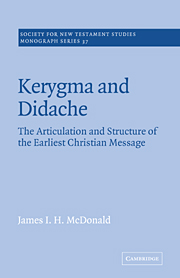3 - Paraenesis and catechesis
Published online by Cambridge University Press: 06 November 2009
Summary
So it is not a piece of paraclesis that I have produced for your benefit, but rather paraenesis.
(Isocrates)I would rather speak five words with my mind, in order to instruct others, than ten thousand words in a tongue.
(St Paul)Paraenesis in the Graeco-Roman world
The paraclesis which Isocrates rejected as an adequate vehicle for the moral education of his young acquaintance Demonicus consisted of the kind of exhortatory discourse beloved of the sophists, those virtuosos of the art of eloquence and persuasion, whose aim in lecturing was primarily to give instruction to students on how to succeed in public life. Though not without skill in this type of oratory, Isocrates adopted a more direct, instructional model for moral teaching: paraenesis, in which exhortation was intimately concerned with the practical problems of living.
This enthusiasm for moral teaching was, of course, shared by more authentic philosophers than many of the paraenetic teachers actually were themselves: by Socrates, for instance, whose view that virtue is knowledge of the good presupposes that it can be taught. Living, like Plato and Aristotle after him, in what has been called ‘the glow and the afterglow of the Periclean age in Athens’, Socrates was able to bring a certain optimism to his view of the world which was alien to later teachers but which provided the essential grounds of his teleology.
- Type
- Chapter
- Information
- Kerygma and DidacheThe Articulation and Structure of the Earliest Christian Message, pp. 69 - 100Publisher: Cambridge University PressPrint publication year: 1980

